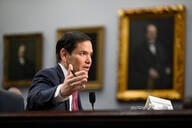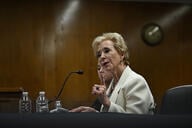You have /5 articles left.
Sign up for a free account or log in.
One year into an experiment allowing colleges to award Pell Grants to incarcerated students, Trump administration officials look to be even more invested in the program.
The question within the Department of Education is not whether the Second Chance Pell program should continue but how to evaluate the results at more than 60 participating institutions as momentum has gathered in Congress behind a possible repeal of the ban on federal aid for incarcerated college students.
The Obama administration launched the Second Chance program in 2015 using its experimental sites authority, which allows the Education Department to circumvent federal statute on a limited basis to evaluate potential policy changes. Republicans criticized the project at the time, focusing largely on the legal authority of the administration to offer the grants.
But support for prison education fits broader rhetoric from the Trump administration about reforming the criminal justice system, a cause championed by presidential son-in-law Jared Kushner in particular.
And political appointees who have recently joined the department have taken a strong interest in the Second Chance program. Diane Auer Jones, the Education Department’s top higher ed official, said the results of the Second Chance program would help inform the administration’s stance on a repeal of the ban, which has been in place since 1994.
“We think with 65 schools and 10,000 students, we have a real opportunity to learn something,” she said. “As institutions provide us with data, we’re really going to look to see, are there best practices? Are there some things that work better than others?”
The department plans to watch student outcomes such as the number and types of degrees or certificates awarded. It will also monitor challenges to providing courses in prison settings and how they were addressed and how students continue their education after release from prison.
Talks involving prison education have also encompassed funding sources outside the Second Chance program. Jones said department officials are looking in particular at allocations states could use under the Adult Education and Family Literacy Act. That law allows states to dedicate up to 20 percent of federal funds awarded through the act to correctional education. In 2015 states spent only $20 million of their federal allocation on that purpose, though, while an additional $94 million could have gone to prison education.
The Perkins Career and Technical Education Act also allows states to spend up to 1 percent of their federal grant award at correctional institutions. The feds can’t dictate how states use those funds. But the department can provide them information clarifying that it can be spent on prison education, Jones said.
“Those are two fairly large pots of money, so to speak, that states tap in to,” she said.
The department’s examination of the prison education has been informed by meetings with advocacy groups and college officials as well as formerly incarcerated individuals.
Jones and Frank Brogan, the assistant secretary of elementary and secondary education, met earlier this summer with a group including Stanley Andrisse, a Howard University medical school endocrinologist. Shortly after graduating college in 2006, Andrisse was sentenced to state prison for a drug conviction but went on to earn a doctorate in physiology and a business degree after his release. He’s now the executive director of From Prison Cells to Ph.D., a nonprofit that provides mentoring and guidance to formerly incarcerated students.
His story, Jones said, helped broaden department officials’ thinking about the kinds of opportunities that should be made available to incarcerated students from career and technical education to four-year liberal arts degrees.
Shifting Politics in Congress
The ban on federal student aid for incarcerated students has been in place for less than a quarter century. It was included in the 1994 federal crime bill signed into law by President Clinton that reflected a broader set of "tough on crime" policies at the time. But as criminal justice reform has become popular among members of both parties, advocates for incarcerated students hope to make progress on reinstating Pell Grants.
And the Second Chance program has taken shape as enthusiasm has grown in Congress -- mostly among Democratic lawmakers -- for reconsidering the ban on federal student aid in prisons, although winning a repeal still appears to be an uphill battle.
House Democrats released a proposal to reauthorize the Higher Education Act last month called the Aim Higher Act including a provision that would strike the ban. The provision was noncontroversial among caucus members, committee staff said. And earlier this year, Senator Brian Schatz, a Hawaii Democrat, introduced legislation that would reinstate Pell eligibility for incarcerated individuals. The Schatz legislation, dubbed the REAL Act, counts among its co-sponsors potential 2020 presidential contenders including Cory Booker, Kirsten Gillibrand, Kamala Harris, Bernie Sanders and Elizabeth Warren.
Although Education Secretary Betsy DeVos called reinstating the grants “a very good and interesting possibility,” congressional Republicans haven't rushed to endorse the proposal.
Some have nonetheless signaled a willingness to consider the idea as part of future higher ed legislation. When the Obama administration made moves to launch the Second Chance program, Senator Lamar Alexander, a Tennessee Republican and chairman of the Senate education committee, said the department did not have the authority to restore the Pell Grants, even on a limited basis, without approval from Congress. But he said earlier this year that reinstating the financial aid could be part of the next Higher Education Act.
“Most prisoners, sooner or later, are released from prison, and no one is helped when they do not have the skills to find a job,” Alexander said in a statement. “Making Pell Grants available to them in the right circumstances is a good idea, and the committee will work to make this a part of the law in a HEA reauthorization.”
Asked about reinstating the grants, a spokeswoman for Representative Virginia Foxx, a North Carolina Republican and the chairwoman of the House Education and the Workforce Committee, said Foxx wanted to see the results of the Second Chance Pell initiative.
Some conservative Republicans have sought to end the Second Chance experiment. Representative Chris Collins, a New York Republican who recently dropped his re-election bid after an insider-trading indictment, has twice introduced legislation dubbed the Kids Before Cons Act that would block the department from administering the program.
But that proposal has received almost no support even from Collins's fellow GOP members. And some conservative policy thinkers have joined with liberals to make the case for prison education as a smart government investment.
Advocates for prison education like Andrisse say higher education is transformational for incarcerated students and significantly reduces recidivism.
“It puts them in physical environments they haven’t been accustomed to, interacting with professors, interacting with other students. All of this is helping build their social capital and their network,” Andrisse said.
But the biggest hurdle for those students in pursuing an education is the cost of college, he said.
“The Pell Grant allows people to start believing, ‘maybe this is for me, maybe I can do this.’ Just by having that opportunity that says that people want to invest in you, that increases a person’s hope,” he said.
One of the alumni of Andrisse’s nonprofit, Donte Small, attended classes through the Goucher Prison Education Partnership while he was incarcerated at Jessup Correctional Institution in Maryland. He was released in 2014, before the launch of the Second Chance program, but eventually continued his undergraduate education at Goucher College’s Towson, Md., campus. He graduated from Goucher this spring with an undergraduate degree in computer science.
The Goucher program at Jessup is now one of the recipients of funding from the Second Chance Pell initiative.
Without the exposure to higher education while at Jessup, Small said, he never would have made it as far as applying to college.
“[If] I hadn’t went to college while I was incarcerated, if I hadn’t had that opportunity to see what I could do while I was incarcerated, I’m not going to apply,” he said. “It gave me the confidence to say, ‘I know I can do it.’”




